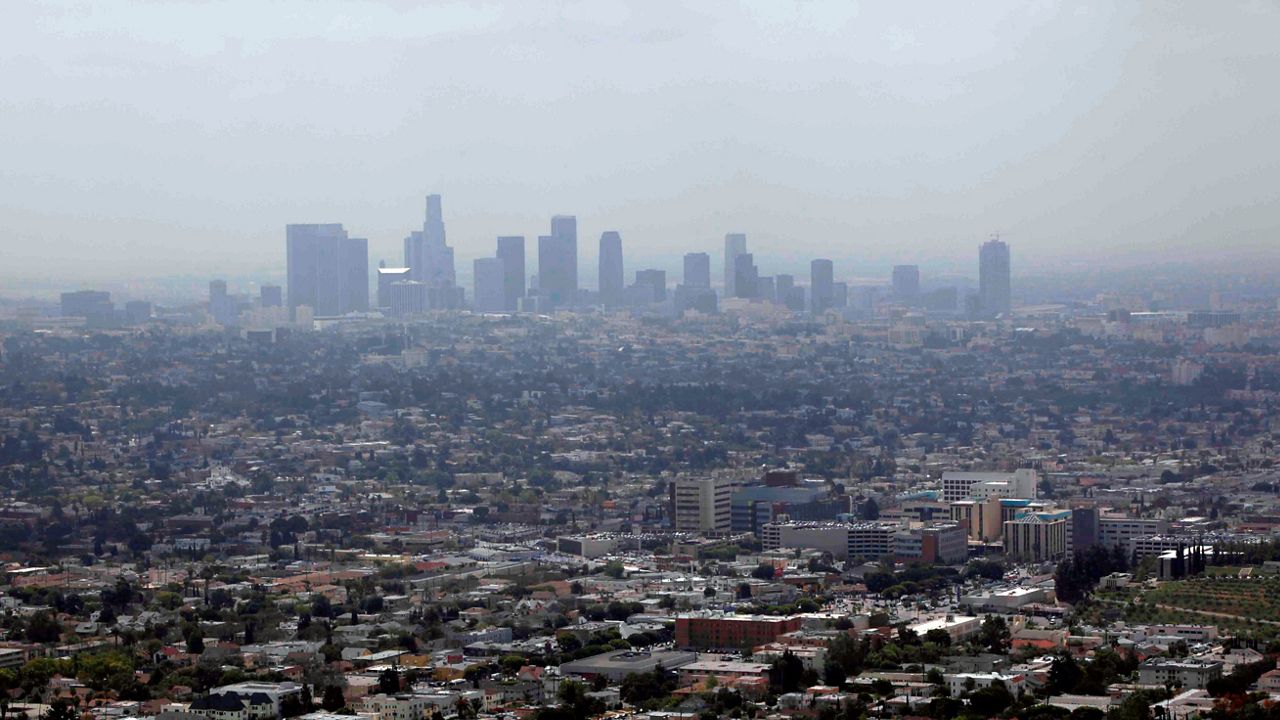Los Angeles and other California cities have the most polluted air in the country, according to the newest State of the Air report from the American Lung Association. The LA-Long Beach region ranked highest for ozone pollution, fifth for annual particle pollution and eighth for daily fine particle pollution, the 2022 report found. Bakersfield, Visalia, Fresno and San Jose-San Francisco-Oakland also scored among the nation’s top 25 most polluted cities on the list.
Released Thursday, the 23rd annual ALA analysis is a national report card on air quality throughout the nation, ranking communities based on ozone (or smog), annual particle pollution (also known as soot) and short-term harmful particle pollution. Numerous scientific studies have shown that ozone and particle pollution can cause premature death and lead to adverse health effects, including asthma, cardiovascular disease and development and reproductive harm. Particle pollution is known to cause lung cancer.
“Too many Americans on too many days of the year are breathing unhealthy air,” said American Lung Association National Senior Director of Clean Air Advocacy, Will Barrett.
The 2022 report found that 137 million Americans, or 40% of the population, live in counties with unhealthy levels of ozone or particle pollution — 2.1 million more people than last year’s report.
The ALA compiled its findings using the most recent U.S. Environmental Protection Agency monitoring data from 2018 to 2020. Barrett said reduced commuter traffic during the early days of the pandemic during 2020 did not show any obvious improvement in air quality.
“In fact, Los Angeles saw one of the worst ozone seasons in recent memory in 2020,” Barrett said.
The report noted significant disparities in the communities that are most impacted. People of color are disproportionately exposed to unhealthy air, the report found. A person of color in the United States is 61% more likely than a white person to live in a county with a failing grade for at least one pollutant and more than three and a half times more likely to live in a county with failing grades across all the report’s metrics.
Lower-income communities and communities of color are more likely to live near sources of harmful truck, train and shipping pollution and to be most affected by it. Eleven of the 25 most polluted American cities for ozone are in California; six are in the top 10. Los Angeles ranked first, having the highest number of unhealthy ozone days since 2010.
While Fresno, Bakersfield, Sacramento and San Diego showed improved ozone levels compared with last year, the report found that 11 California cities ranked in the nation’s top 25 for short-term particle pollution, with Fresno ranking first. Nine California cities were most polluted for year-round particle pollution, with Bakersfield ranking first. Bakersfield ranked among the top three nationally for all pollutants, largely due to transportation.
Transportation represents about 50% of the state’s greenhouse gas emissions, according to the California Air Resources Board. It also generates 80% of the state’s oxides of nitrogen emissions — the compound that forms ozone and leads to secondary particulate pollution.
“The fact is, we can’t get to clean air for all Californians or reach our greenhouse gas reduction targets without transitioning away from burning petroleum,” said California Air Resources Board Executive Officer Richard Corey. “The data doesn’t lie. This is the fact.”
Corey said his agency is advancing regulations and incentive programs to electrify all aspects of the transportation sector, from cars and trucks to marine vessels and railways.
Last month, the American Lung Association released a report that found the state could experience $95 billion in public health benefits between 2020 and 2050 by transitioning the entire transportation sector and electricity generation to zero emissions. Doing so would prevent premature deaths, asthma attacks and lost workdays, the report said.
While transportation is the leading source for ozone pollution in California, particle pollution is increasing because of catastrophic wildfires. The 2022 State of the Air report saw major short-time spikes in particle pollution as a result of the record-breaking 2020 wildfire season. That year saw four out of the five largest wildfires in California history, resulting in 41 of the state’s 45 counties whose data was reflected in the report showing increased particle pollution days. More than 30 of those counties had higher year-round particle pollution than last year’s report.
The report also found that climate change is degrading air quality across the country. Rising temperatures and other impacts associated with climate change contribute to increased ozone pollution and more frequent and intense wildfires, blanketing millions of Americans in smoke and particle pollution with increasing frequency, Barrett said.
Particle pollution resulting from wildfires is worst on the West Coast, where wildfires have become more frequent, intense and catastrophic. This year’s report found that 9 million more people were impacted by deadly particle pollution than the last State of the Air analysis.
“We saw more days with very unhealthy and even hazardous air quality levels than ever before in the two-decade history of the report,” Barrett said.
Nearly every city in the report’s top 25 most polluted by short-term spikes and particle pollution is in the Western United States.
“Climate change is making the job of cleaning the air much more difficult,” Barrett said.
The American Lung Association is advocating for the federal government to speed the transition to zero-emission transportation and electricity to help reduce air pollution. Specifically, it is advocating for stronger national policies on particle pollution and ozone standards to clean up pollution sources, including a strong federal standard for heavy-duty truck pollution. The U.S. Environmental Protection Agency is scheduled to set those standards later this year.



